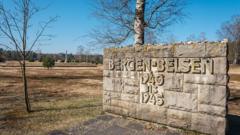Eighty years ago, the horrific truths about Nazi concentration camps were unveiled when British and Canadian troops liberated Bergen-Belsen in April 1945. Despite rumors and prior reporting, the revelation of the camp's conditions was staggering. Troops discovered around 13,000 unburied corpses amidst 60,000 skeletal survivors suffering from disease and starvation. This Sunday, over a thousand survivors and their families convened to mark the anniversary with solemn ceremonies.
One British soldier, Michael Bentine, described Belsen as "the ultimate blasphemy," while the BBC's Richard Dimbleby, who was among the first reporters to enter the camp, stated, "This day at Belsen was the most horrible of my life." Unlike other camps, which the Nazis attempted to conceal, the evidence at Belsen was pervasively intact, where many victims from eastern camps ended up. The conditions were dire, leading to daily deaths from malnutrition and outbreaks of typhus.
Among those who perished weeks before liberation were notable figures like Anne Frank and her sister Margot. As the war drew to a close, around 50,000 to 70,000 individuals died at Belsen, including many who succumbed shortly after liberation due to poor health. The camp primarily housed Jews, alongside Soviet prisoners, Sinti, and homosexuals, all victims of systemic brutality.
During the memorial event, 180 British Jews participated in the remembrance, organized by the Jewish Military Association (Ajex). They were joined by notable figures, including Deputy Prime Minister Angela Rayner, as well as Chief Rabbi Sir Ephraim Mirvis, who shared prayers.
Today, the site of Bergen-Belsen is transformed, with remnants of the original camp mostly erased to prevent disease spread. A visitor center and memorial stones remain as poignant reminders of the tragedy, forging a space for remembrance amidst a landscape that once embodied unbearable suffering. One inscription reads: "Here rest 5,000 dead," a testament to the lives lost and the memories that escape the passage of time.





















